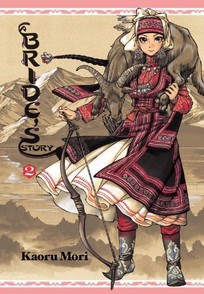Review
by Rebecca Silverman,A Bride's Story
GN 2
| Synopsis: |  |
||
As Amir and Karluk grow closer, Amir also learns more about life in a settled community. A trip to the communal ovens gains her a friend as well as a new archery student. But when Amir's family comes to forcefully dissolve her marriage and take her back to the tribe, will Karluk and his family simply allow her to go without a fight? |
|||
| Review: | |||
Bread baking. Sheep herding. Embroidery. These are just some of the everyday activities of mid-to-late-19th century Central Asia that Kaoru Mori touches on and devotes chapters to in her leisurely tale A Bride's Story. Volume two opens with Amir baking bread in the communal ovens. At first none of the other women will grant her space to shape her flat bread, but brash Pariya (a variation of an Indian name meaning “beloved”) saves the day. Pariya also teaches Amir how to make the local variety of decorated flat loaves, quickly cementing her place as Amir's first real friend. Do not let this slow and sweet beginning fool you, however. Chapters two and three deal with the return of Amir's nomadic clan. The first volume hinted at their need for Amir as a bargaining chip with the fictitious Numaji tribe, and now they come riding in with every intention of storming the town to pull it off. Mori proves that she can draw action in these chapters, as the nomads stage a raid and the townsfolk, determined to protect a woman they now see as one of their own, fight back with whatever they have. There is a real feeling of urgency here, from the nomads' desperation (these Numaji must be the heirs to Ghengis Khan's personality) to the villagers' refusal to give up. Amir and Karluk of course play key emotional roles. Karluk's is the stronger, with a touching need to protect his wife and prove that he is the man his family doesn't quite treat him as. Amir, on the other hand, may disappoint some readers. Up to this point we have known her as the bow-hunting, snub-dodging protagonist who takes no guff and carries her own weight. These chapters, however, show her shaking in the corner while her tribe attacks the village, or clinging to her underage husband in abject fear. While it is certainly easy to sympathize with her plight – she has a safe, comfortable situation with an undemanding, kind spouse, and the Numaji are clearly terrifying – it would have been nice to see her react with more gumption rather than letting Karluk and his family do the fighting for her. The relationship between husband and wife may still raise a few eyebrows, if not more than in the first volume, as Amir is clearly developing feelings for Karluk. The chapter “Heart of a Bride,” which comes directly after the battle, has Amir feeling uncomfortable around her husband, presumably in context of having seen him as a man for the first time as he defended her. This is a common enough trope in most forms of literature, and certainly marriages with such an age gap were normal when the story is set, but readers uncomfortable with the premise should go into this warned. There is still no sexual content whatsoever (unless you consider a tickle fight sexy), but it is uncertain how long that will hold true. On the subject of the setting, Mori gives us our first real clue when Mr. Smith receives a letter: the Russians, it seems, are encroaching. This tells us that the tale is set sometime between 1865 and 1917. Given Mr. Smith's garb, and that of the other Westerners who show up this volume, a date between 1880 and 1890 seems most likely. This also connects with the Asian characters' clothing, which look to be variations on the Mongolian deel. Likewise this may suggest that the city he mentions at the end of the volume is Khovd, the capital of the province of the same name in the west of the country, nearer to Russia. These clues are especially interesting to readers who are in this for the setting and other anthropological aspects, as it provides the historical background so elegantly given in Mori's other series Emma. As always, Mori's art is spectacular, with an astounding amount of detail in every image. The chapter on embroidery provides a wonderful showcase for her style, with traditional symbols explained and cataloged. Crafting readers may also pick up some instruction in recreating the designs, as Mori's panels also show the process of creating the designs. Characters continue to be expressive and newcomer Pariya has a distinctly Middle Eastern look about her. This is, like its predecessor, a book to be visually savored. Whether you are reading this for the art, the anthropology, or the slowly building romance, A Bride's Story is a real treat. It still isn't a series for everyone, as the age gap will be problematic for some readers and the slow pace will bore others, but Amir's good heart and Karluk's earnestness help humanize what might otherwise be a dry treatise on Central Asian life. Like drizzling molasses on hot cornbread, reading this book is a slow process that is ultimately worth the time. |
|
The views and opinions expressed in this article are solely those of the author(s) and do not necessarily represent the views of Anime News Network, its employees, owners, or sponsors.
|
| Grade: | |||
Overall : A-
Story : B
Art : A
+ Exquisitely detailed artwork, likeable characters, and more action than the last time. |
|||
| discuss this in the forum (10 posts) | | |||
| Production Info: | ||
|
Full encyclopedia details about Release information about |
||